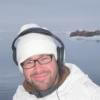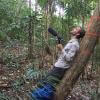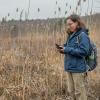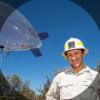Acoustic sensors enable efficient and non-invasive monitoring of a wide range of species, including many that are difficult to monitor in other ways. Although they were initially limited in application scope largely due to cost and hardware constraints, the development of low-cost, open-source models like the Audiomoth in recent years has increased access immensely and opened up new avenues of research. For example, some teams are using them to identify illicit human activities through the detection of associated sounds, like gunshots, vehicles, or chainsaws (e.g. OpenEars).
With this relatively novel dimension of wildlife monitoring rapidly advancing in both marine and terrestrial systems, it is crucial that we identify and share information about the utility and constraints of these sensors to inform efforts. A recent study identified advancements in hardware and machine learning applications, as well as early development of acoustic biodiversity indicators, as factors facilitating progress in the field. In terms of limitations, the authors highlight insufficient reference sound libraries, a lack of open-source audio processing tools, and a need for standardization of survey and analysis protocols. They also stress the importance of collaboration in moving forward, which is precisely what this group will aim to facilitate.
If you're new to acoustic monitoring and want to get up to speed on the basics, check out these beginner's resources and conversations from across the WILDLABS platform:
Three Resources for Beginners:
- Listening to Nature: The Emerging Field of Bioacoustics, Adam Welz
- Ecoacoustics and Biodiversity Monitoring, RSEC Journal
- Monitoring Ecosystems through Sound: The Present and Future of Passive Acoustics, Ella Browning and Rory Gibb
Three Forum Threads for Beginners:
- AudioMoth user guide | Tessa Rhinehart
- Audiomoth and Natterjack Monitoring (UK) | Stuart Newson
- Help with analysing bat recordings from Audiomoth | Carlos Abrahams
Three Tutorials for Beginners:
- "How do I perform automated recordings of bird assemblages?" | Carlos Abrahams, Tech Tutors
- "How do I scale up acoustic surveys with Audiomoths and automated processing?" | Tessa Rhinehart, Tech Tutors
- Acoustic Monitoring | David Watson, Ruby Lee, Andy Hill, and Dimitri Ponirakis, Virtual Meetups
Want to know more about acoustic monitoring and learn from experts in the WILDLABS community? Jump into the discussion in our Acoustic Monitoring group!
Header image: Carly Batist
Please join us in celebrating this year’s top #Tech4Wildlife Photo Challenge Honorees as chosen by our panel of leading conservation organization judges, and enjoy the story contained within these entries about how our...
4 August 2023
Exciting opportunity for an experienced biodiversity monitoring expert in ZSL's conservation department
18 July 2023
Global methane data and new functionaity on the Carbon Mapper Data Portal
12 July 2023
Apply to work with an absolutely all-star group developing AI/ML techniques and models for acoustic monitoring!
28 June 2023
The GSMA ClimateTech programme
21 June 2023
Job opportunity in Leiden, The Netherlands
9 June 2023
Careers
Permanent and Full Time role at the UK Centre for Ecology & Hydrology
8 June 2023
Field Inclusive, Inc. is offering a $2000 travel award to students to attend bird-focused conferences, workshops, and trainings. Interested acoustic monitoring community members should apply by July 31st for...
2 June 2023
In this research, six acoustic indicators were used to evaluate the sound of the urban soundscape and the sound of birds in urban parks. The results of the research show that there is a significant relationship between...
2 May 2023
If you've been waiting to try a HydroMoth, join the GroupGets campaign before limited supplies run out
17 April 2023
The Project Manager will work to implement acoustic monitoring projects in countries worldwide with some of the biggest stakeholders in conservation tech and biodiversity monitoring!
12 April 2023
April 2024
June 2024
July 2024
event
February 2024
December 2023
event
Bird Acoustic Surveys: Comparison with traditional transect methods
6 November 2023 9:32am
2 January 2024 3:28pm
Thanks for taking the time to respond and share these articles!
3 January 2024 4:55pm
A very nice read, especially for me someone new to the field as myself. Nice to see all of the various approaches and to know I wasn't re-inventing the wheel but adding something new (Potential new platform for real time localization).
Looks like my timing wasn't ideal to be included in your summary. Maybe for version #2 :)
Thanks for sharing!
Practical sound localization on the Raspberry Pi
17 December 2023 5:31pm
18 December 2023 11:24pm
Worth a read? The synopsis sounded very star trek like.
21 December 2023 6:22am
Probably not unless you are old enough to be nostalgic. I don’t think that’s you Brett 😀
31 December 2023 10:55am
Cool! My Sound Localization project has hit hackaday. The use case of fireworks localization was pure sensationalism.
Hydromoth for coastal & offshore surveying
16 November 2023 7:36am
18 November 2023 1:47am
Hi Sol,
I think your concern is well placed. The pros typically tow an array of hydrophones, in its simpler configuration it looks like a long fat rubber hose containing maybe a dozen transducers feeding their electrical signals to a recording unit back on the ship. All this is done to reduce noise from the ship, from waves crashing, and flow noise. The multiple transducers can also be electronically tuned to be directional so that it can be "pointed" away from a noise source (like the ship).
In your position, I would just try the simplest thing that could work, then fix the problems as they arise. It could be you may need to be dead in the water while recording. To address surface noise (slapping waves, wind), you could mount the hydromoth low down on a spar buoy, which you tow into position.
Best of luck, it sounds like an interesting project (c:
19 December 2023 2:20pm
Hydromoths are great for the price but they do not have the most streamlined housing and audio quality won't be as good as something like a SoundTrap or really any recorder with a proper hydrophone and 16-bit +DAQ system.
If you can afford it, this is an excellent SoundTrap based towed autonomous system NOAA have been using. It might work towed behind an autonomous vehicle
Alternatively, if you can have something inside the vehicle, a simple tape recorder (e.g. Tascam DR40X) and hydrophone on cable will provide excellent sound quality. You could also use something like a Raspberry Pi with audio focussed ADC hat to record but that would require a bit more programming. Even consider a standard AudioMoth and plug a proper hydrophone into the audio jack - this would still have a 12-bit ADC but would provide better sound quality than a hydromoth (hydrophones are more omnidirectional and there's no air filled causing reflections and attenuation)
20 December 2023 6:57am
If you are considering an external microphone and a towed system, then you would also be in a position to consider a raspberry pi with an external microphone with sbts-aru. Another option:
New Raspberry Pi Sound Localizing ARU is now fully released and ready for use
7 October 2023 2:10pm
18 December 2023 3:42pm
Hi @chrisgnicholas ! AudioMoth has a pipeline for exactly that:
Cheers,
Lars
18 December 2023 7:06pm
Very cool, real-time audio pattern matching is exactly what I meant! I'd love to hear updates as it goes.
18 December 2023 7:29pm
When I designed the recorder. I chose it to use jackd2 instead of pulse audio or direct alsa access because unless I was mistaken it could support multiple consumers of the sound source and the other approaches not.
Originally its purpose was part of my security system so it records as well as being able to connect and listen live. That’s simply a case of also installing icecast2 and darkice onto the same system. Then I discovered bio-acoustics and pivoted and then discovered wildlabs 😀
In principle you could both those things as well as real time audio pattern matching no problem.
Which market-available microphones, accelerometers and GIS sensors for dogs / pets ?
7 September 2023 3:21pm
6 December 2023 2:03pm
good to know that GPS coordinates can be used to sync the time.
Does GPS resolution allow to a desired time resolution (e.g. seconds) ? Does choice of time resolution significantly depends on the physiology of the animal (e.g. time of re-action to stimuli, hence less than a second) or for most animal communication and animal behaviour is it enough above a second?
7 December 2023 7:03am
Hi Luigi!
It is not the coordinates but the information from the "pulse per second" from the GPS which is used for the time sync.
Have a look at
17 December 2023 3:02pm
I am not an acoustics person but train and deploy canines in the field. Are you looking for something that records sniff rate and patterns? For GPS I just use a Garmin collar system Altha 100. There is a Conservation Canine group that might be worth asking your question in.
Call for Interview Subjects: Conservation Bioacoustics Methods
14 December 2023 8:47pm
15 December 2023 12:19pm
Happy to help Samuel, will send a message
15 December 2023 3:46pm
I'd love to!
16 December 2023 9:43am
Thank you Stefan! Will follow up with your email shortly.
Low-cost hydrophone - Invitation to tender
15 December 2023 9:28pm
Sustainable land managment
15 December 2023 3:38pm
Geospatial data training and education for conservation
15 December 2023 3:20pm
Sharing our startup's webpage, featuring information about our services and products.
We are open for new partnership, collaboration R&D project in the field of GIS data analysis.
Conservation of Kikuyu Escarpment Forest
1 December 2023 12:38pm
Deploying Song Meters in Nigeria
24 November 2023 9:01am
28 November 2023 3:08pm
Hi Joan,
Sounds like a great project! I would recommend having a look at some of the nice review literature and guidelines that are out there, like -
- https://www.researchgate.net/publication/368683386_Good_practice_guidelines_for_long-term_ecoacoustic_monitoring_in_the_UK
- https://academic.oup.com/bioscience/article/69/1/15/5193506 (Terrestrial Passive Acoustic Monitoring: Review and Perspectives)
- https://zslpublications.onlinelibrary.wiley.com/doi/full/10.1002/rse2.227 (Optimizing tropical forest bird surveys using passive acoustic monitoring and high temporal resolution sampling)
- https://onlinelibrary.wiley.com/doi/full/10.1111/brv.12890 (Acoustic indices as proxies for biodiversity: a meta-analysis)
- https://besjournals.onlinelibrary.wiley.com/doi/full/10.1111/2041-210X.14194 (Using acoustic indices in ecology: Guidance on study design, analyses and interpretation)
And some specific to nocturnal birds:
- https://pdfs.semanticscholar.org/f720/4b65248c2d9335dc0b70d1ac3b748145398e.pdf (In the still of the night: revisiting Eastern Whip-poor-will surveys with passive acoustic monitoring)
- https://link.springer.com/article/10.1007/s10531-023-02642-7 (Passive acoustic monitoring in difficult terrains: the case of the Principe Scops-Owl)
- https://www.tandfonline.com/doi/abs/10.1080/01650521.2021.1933699 (Passive acoustic monitoring of the Ferruginous Pygmy-Owl (Glaucidium brasilianum) over a complete annual cycle: seasonality and monitoring recommendations)
- https://www.biorxiv.org/content/10.1101/2023.05.22.541336v1.abstract (Nighthawk: acoustic monitoring of nocturnal bird migration in the Americas)
And a study on bird acoustic monitoring in Nigeria:
- https://www.sciencedirect.com/science/article/pii/S1470160X20312115 (Passive acoustic monitoring gives new insight into year-round duetting behaviour of a tropical songbird)
In terms of processing and analyzing the data, I work for Rainforest Connection which maintains Arbimon - a free, no-code ecoacoustic analysis platform to help automate species detection and classification within soundscapes. If you're interested, you can get started with our support docs!
There are also a number of stats packages for analyzing soundscape data (seewave, monitoR, warbleR in R; and OpenSoundscape, scikit-maad in Python).
AWMS Conference 2023
New book: Sound Identification of Terrestrial mammals
17 November 2023 1:55pm
Flying with li-ion batteries
15 November 2023 8:24pm
16 November 2023 2:26am
The 18650s should be packed in discrete holders to separate them and prevent them from shorting. I've taken up to 50 on a plane before. 100 might be a tall ask since most planes have limitations on total Amp Hours you can bring.
Good luck.
16 November 2023 4:01pm
Thanks Akiba, good to know you had no problems with those, and those cases look good. Having read a bit more, it actually seems that in theory there is no limit to the number of batteries you can bring, as long as each is <100Wh. Seems like I'll be testing that theory...
PhD Opportunity - Marine Bioacoustics and Behaviour Lab
16 November 2023 2:13pm
PhD Opportunity - Real-time acoustic monitoring of insect pollinators and their behaviours
16 November 2023 12:48pm
Software Engineer at Rainforest Connection & Arbimon
14 November 2023 12:30am
Seeking AudioMoth in SF Bay Area
6 November 2023 8:48pm
7 November 2023 9:10pm
I have an AudioMoth that they are welcome to. I'm down in Moss Beach (just north of Half Moon Bay).
8 November 2023 10:28pm
You're awesome Tim, thank you! However, we ordered another from GroupGets yesterday and it's arriving tomorrow, so we (should) be good to go : ) Now if I can only get LabMaker to reimburse me for the one that didn't arrive, that would fix everything. Unfortunately they've been incredibly slow to reply ....sigh
Replacement (cheaper) foam mic covers
23 October 2023 3:35pm
3 November 2023 3:04pm
Hi! I got these ones from Amazon. Also, I was tired of creatures eating them so I created a shield using window mesh screen 
6 November 2023 9:31am
Hi - thanks for your reply. I've been thinking along the same lines though unsure where I'd purchase 'acoustic foam' from. I've made 'dead cats' before for some of my active monitoring mics and that material is not too difficult to source but the only acoustic foam I've come across is the type for deadening sound in studio etc. - the exact opposite of what I want!! The search continues ....!
6 November 2023 9:33am
Brilliant - thank you.! Great idea about the screen too - I'm replacing some of them monthly so may try that myself. Have you found any issues with the mesh generating any tones with wind?
Digital Signals Processing - free online textbook
31 October 2023 1:50pm
I just discovered this freely available book on digital signal processing and love the fact that it is“…intended for students … who may not have much mathematical or engineering training.” Seems like a great resource for bioacoustics, biologing etc!
Searching for researchers working in Africa
25 September 2023 1:57am
20 October 2023 7:45pm
Hi Andrew,
Rainforest Connection (RFCx) has projects in a couple different countries in that region, and also working with agroforestry systems to monitor biodiversity using acoustic monitoring! You can read more about that project (Kenya) here: https://rfcx.org/blog/monitoring-biodiversity-in-kenyan-agroforestry-parcels. We've also got a project working with small-scale cacao farmers in Colombia to monitor biodiversity in their cacao plots. For some background, RFCx is a non-profit focused using sound and AI to monitor biodiversity and detect threats, and we also manage the Arbimon acoustic analysis platform.
I'd be happy to talk through ideas further if you'd like, feel free to reach out! [email protected]
All the best,
Carly
21 October 2023 12:13am
HI Andrew,
I am replying to the "elsewhere". I am based in Aus but travel and work in the Arts/ Science field of field recording, often with scientists. I have been acoustic monitoring a peri-urban site in Victoria with a local council. The subject is a wetland, transferring from farmland to a wetland public space that is now surrounded and impacted by urban infrastructure. I was lucky enough to get sounds before, during and after CoVid lockdowns so we can hear a stark comparison of anthropogenic sound.
I'd love to chat further about this and other work I do if this fits your collaboration criteria.
Best,
Vicki
31 October 2023 1:56am
Hi Vicki,
I've sent you a private message.
Ecoacoustic Bird Survey White Paper
30 October 2023 3:48pm
PAM workflow and file question
27 October 2023 3:50pm
29 October 2023 10:59am
Like this:
ffmpeg -i input.wav -f segment -segment_time 60 -c copy output%03d.wav
30 October 2023 1:17pm
Thank you!
30 October 2023 1:17pm
Thank you!
In case you missed it... (no.2)
27 October 2023 1:20pm
Acoustic Monitoring Specialist
26 October 2023 7:32pm
5 Trailblazing Wildlife Monitoring Tech Solutions across East Africa. What Monitoring Technologies are you using?
25 October 2023 12:40pm
Soundscapes and deep learning enable tracking biodiversity recovery in tropical forests
20 October 2023 3:38pm
New paper in Nature Communications from Jörg Müller et al. using BAR-LT recorders and CNNs to track biodiversity recovery. Study shows that #soundscapes 🎙🎶 and deep learning are powerful tools for tracking biodiversity recovery in tropical forests
PhD Opportunity: YELLOWHAMMER - Individual acoustic monitoring to study song culture evolutionwithin and between dialect areas
20 October 2023 12:54pm
PhD Opportunity: Distributed sound source localisation and separation for wireless microphone networks consisting of two-microphone nodes
20 October 2023 12:47pm




































4 December 2023 11:36am
Hi Theresa. In comparison to traditional survey, I think that the time/cost benefits of acoustics are good. Certainly the set-up, maintenance, and data management requirements are minimal. And if there is significant travel time to site, and the recording period of acoustic survey is long, then I think the benefits are compounded (i.e. there are economies of scale to acoustics that you don't get with trad surveys).
Until the last year or two, the data analysis for species identification has been the time-consuming part. However, now that systems such as BirdNET are available, this issue is fairly well dealt with (but still needs a little bit of skill/experience).
A couple of scientific papers have assessed these costs/benefits - I hope these make an interesting read.
Carlos